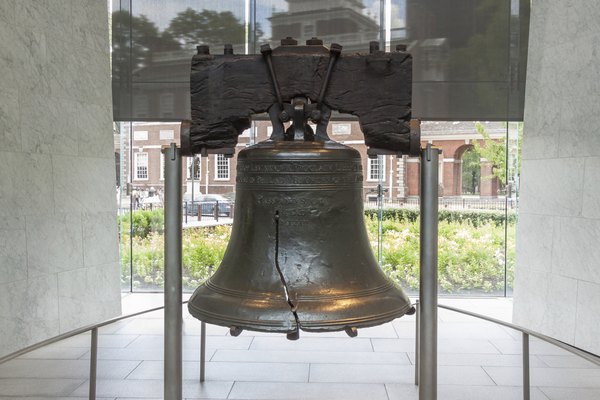Pennsylvania stretches from the Delaware Estuary north and westward for more than 280 miles through five land regions. Pennsylvania’s plains, mountains, ancient volcanic hills and plateaus set the stage for historic events. American patriots battled the English in the lowland southeast, and a 20th century architect designed a world-famous home that blends with surrounding landforms in the hilly west. Each land region offers its own brand of attractions, from national shrines and museums to scenic hiking and wine trails.
Atlantic Coast Plain -- Where America Declared Independence
The Atlantic Coast Plain extends diagonally across Pennsylvania’s far southeastern corner and borders the Delaware River as it flows southward toward the Atlantic Ocean. Philadelphia, the state’s largest city, sits in this lowland area. History abounds in the region, particularly events surrounding America’s fight for independence. At Independence Hall National Historical Park, you can visit the site where the Declaration of Independence was signed and see the Liberty Bell, one of America’s most important symbols. About 20 miles northwest of Philadelphia, visit Valley Forge, the site where General George Washington’s Continental Army endured a frigid winter in 1777-78. A guided trolley tour takes visitors through the reconstructed encampment.
The Piedmont -- Pennsylvania Dutch Country
The Piedmont extends even farther northwestward from Pennsylvania’s southeast corner, separated from the plain by heavy volcanic rock. Characterized by rolling hills and ridges, the rich soil attracted immigrant farmers, many from Germany who later became known as the Pennsylvania Dutch. Stroll downtown Lancaster, the heart of Pennsylvania Dutch country, to shop for antiques or sample chicken pot pie. Twenty-five covered bridges dot the countryside where you might see a horse and buggy transporting Amish folks on country roads. Further north visit Bethlehem, a settlement founded by the Moravians, a religious group, in 1741. Costumed interpreters welcome visitors to tour historic buildings, including a mill. The eclectic Moravian Book Shop, established in 1745, sits in Bethlehem’s historic downtown and is one of the oldest bookstores in the world.
Ridge and Valley -- The Capitol Sits Here
The Ridge and Valley land region extends from Pennsylvania’s south-central border, northeast toward New Jersey. It encompasses the Appalachian Mountain range punctuated by gaps and valleys. Harrisburg, the state’s capital, sits in a mountain gap. The Capitol building offers tours that highlight the ornate dome, patterned after St. Peter’s Basilica in Rome. The nearby National Civil War Museum traces the period from 1850 to 1876 with historical artifacts and interpretation, including items owned by President Abraham Lincoln. About 230 miles of the 2,185-mile Appalachian National Scenic Trail traverses the region, offering easy day and longer hikes.
Allegheny Plateau -- Forests and Rivers
Pennsylvania’s largest region is the Allegheny Plateau, encompassing almost half of the state’s north and west sector. Characterized by hills and low mountains, more than half of the high plateau is forested. The Allegheny National Forest covers about 515,000 acres, offering many recreational possibilities, from canoeing and camping to hiking and snowmobiling. Pittsburgh, the region’s major city, marks the spot where two regional rivers, the Allegheny and Monogahela, join to form the mighty Ohio River. The city boasts several museums, including the Carnegie Museum of Art and the Andy Warhol Museum. Southeast of Pittsburgh, architect Frank Lloyd Wright designed a house that blends with its surroundings. Called Fallingwater, the house was built on a hillside over a cascading waterfall. Visitors can tour the home.
Lake Erie Plain -- 50 Miles of Coastline
The state’s smallest region hugs the Lake Erie shoreline in far northwest Pennsylvania. The plain extends only a few miles inland and was once part of the lake. The city of Erie features the Erie Maritime Museum. It houses the reconstructed U.S. Brig Niagara, a ship that played a pivotal winning role in the War of 1812. Suitable for grape growing, the region boasts eight wineries situated along the Lake Erie Wine Trail.
References
- Maps of the World: Pennsylvania
- e-Reference Desk: Pennsylvania Geography: The Land
- National Park Service: Independence Hall National Historical Park
- National Park Service: Valley Forge National Historical Park Touring the Park Visit
- Discover Lancaster: Covered Bridges
- Discover Lancaster: Amish
- The Chamber: About Bethlehem
- Visitpa.com: Harrisburg Pennsylvania Things to Do
- National Civil War Museum: About Us
- Pennsylvania Department of Natural Resources: Appalachian Trail
Photo Credits
- Thinkstock/Stockbyte/Getty Images








